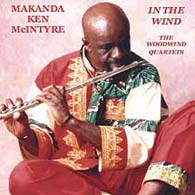read
 biography
biography
 reviews
reviews
 liner notes
liner notes
 interviews
interviews
 books
books
 CAAMO
CAAMO
 tributes
tributes
 biography
biography
 reviews
reviews
 liner notes
liner notes
 interviews
interviews
 books
books
 CAAMO
CAAMO
 tributes
tributes
Review by Nils Jacobson
November 3rd, 2004 - AllAboutJazz
Multi-intrumentalist Makanda Ken McIntyre seems to have invested as much of himself into education as performance, which is one reason he didn't accumulate more than a dozen records under his own name during his lifetime (1931-2001). But his work on these titles (from 1960's Stone Blues and Looking Ahead through 2001's A New Beginning ), as well as efforts led by Cecil Taylor ( Unit Structures ) and Charlie Haden's Liberation Music Orchestra ( Montreal Tapes and Dream Keeper ), among many others, helped to earn him an underground audience.
McIntyre was a traveler through both sound and space (in the '90s he lived in Bolivia, served as a Jazz Ambassador to the Middle East, and picked up the name "Makanda," which means "many skins" or "many heads," in Zimbabwe). For In the Wind, a posthumous release which was recorded in '95 and '96, McIntyre accompanies himself by the magic of overdubbing on 13 different instruments in four different quartet configurations: clarinets, double reeds, flutes, and saxophones. Since all the compositions are his own, it's a very personal affair. All Makanda, all the time.
Most of In the Wind has the intimate, private feel of chamber music, whether it's tense, ebullient, or exploratory. It's delivered in measured portions of five to ten minutes in length, and the combos are mixed up over the course of the record.
Woodwind quartets have found their greatest popularity in the hands of the World Saxophone Quartet, and the two saxophone pieces on In the Wind bear interest: the relatively quiet but tension-laden "Black Sugar Cane" features solos on each instrument, covering the range; the calypso "Puunti," named after his sister, conveys a purely joyous and celebratory mood. But the clarinets on "Mambooga" offer some of the most intricate arrangements and are just plain entertaining to listen to. I can't say I much enjoyed the three flute pieces, which seemed to lack the spark of the rest, but your mileage on that front may vary with your tolerance of the instrument(s). The double reed pieces balance the mellowness of the English horn against the sharp edge of the oboe, and frequently (as on "Chasing the Sun") the results can be quite unpredictable.
I know McIntyre meant this to be a personal project, but I found myself thinking at several points while listening to the record that it would have been nice if these tunes could have been performed without overdubbing. McIntyre turns in an inspired show, but it's missing some of the energy that comes from live performance. However, all but one of these pieces have appeared elsewhere on record with rhythm sections, so you can find the appropriate reference points if you look. In the meantime, In the Wind offers a lot of creative interplay, and you'll benefit from listening closely.
November 3rd, 2004 - AllAboutJazz
Multi-intrumentalist Makanda Ken McIntyre seems to have invested as much of himself into education as performance, which is one reason he didn't accumulate more than a dozen records under his own name during his lifetime (1931-2001). But his work on these titles (from 1960's Stone Blues and Looking Ahead through 2001's A New Beginning ), as well as efforts led by Cecil Taylor ( Unit Structures ) and Charlie Haden's Liberation Music Orchestra ( Montreal Tapes and Dream Keeper ), among many others, helped to earn him an underground audience.
McIntyre was a traveler through both sound and space (in the '90s he lived in Bolivia, served as a Jazz Ambassador to the Middle East, and picked up the name "Makanda," which means "many skins" or "many heads," in Zimbabwe). For In the Wind, a posthumous release which was recorded in '95 and '96, McIntyre accompanies himself by the magic of overdubbing on 13 different instruments in four different quartet configurations: clarinets, double reeds, flutes, and saxophones. Since all the compositions are his own, it's a very personal affair. All Makanda, all the time.
Most of In the Wind has the intimate, private feel of chamber music, whether it's tense, ebullient, or exploratory. It's delivered in measured portions of five to ten minutes in length, and the combos are mixed up over the course of the record.
Woodwind quartets have found their greatest popularity in the hands of the World Saxophone Quartet, and the two saxophone pieces on In the Wind bear interest: the relatively quiet but tension-laden "Black Sugar Cane" features solos on each instrument, covering the range; the calypso "Puunti," named after his sister, conveys a purely joyous and celebratory mood. But the clarinets on "Mambooga" offer some of the most intricate arrangements and are just plain entertaining to listen to. I can't say I much enjoyed the three flute pieces, which seemed to lack the spark of the rest, but your mileage on that front may vary with your tolerance of the instrument(s). The double reed pieces balance the mellowness of the English horn against the sharp edge of the oboe, and frequently (as on "Chasing the Sun") the results can be quite unpredictable.
I know McIntyre meant this to be a personal project, but I found myself thinking at several points while listening to the record that it would have been nice if these tunes could have been performed without overdubbing. McIntyre turns in an inspired show, but it's missing some of the energy that comes from live performance. However, all but one of these pieces have appeared elsewhere on record with rhythm sections, so you can find the appropriate reference points if you look. In the meantime, In the Wind offers a lot of creative interplay, and you'll benefit from listening closely.

